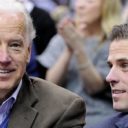KIEV, UKRAINE – Anti-government Ukraine protests resulted in the toppling of a statue of former Soviet leader Vladimir Lenin in the center of Kiev on Sunday. Angry protestors blockaded key government buildings amid massive crowds in protests, increasing the pressure on President Viktor Yanukovych, whom they are demanding be removed from office.
The biggest protest in the former Soviet republic since Ukraine’s pro-democracy Orange Revolution in 2004 led the government to fire back. The government announced an investigation into opposition leaders for an alleged attempt to seize power, warning the demonstrators they will face criminal charges if they persist.
Hundreds of thousands of Ukrainians flooded the center of the capital city of Kiev, demanding Yanukovych be ousted following his decision to break ties with the EU in favor of closer relations with Russia.
Hundreds of police in full riot gear flooded into the center of Kiev to break up an earlier protest in the nearly three-week standoff.
“Ukraine is tired of Yanukovych. We need new rules. We need to completely change those in power,” said protester Kostyantyn Meselyuk, 42. “Europe can help us.”
Independence Square is truly filled with anti-Russia protestors as far as the eye could see, Ukrainians waving European Union flags sang the national anthem and shouted “Resignation!” and “Down the with Gang!” in a reference to Yanukovych’s regime.
“I am convinced that after these events, dictatorship will never survive in our country,” world boxing champion and top opposition leader Vitali Klitschko told media reporters. “People will not tolerate when they are beaten, when their mouths are shut, when their principles and values are ignored.”
The conflict escalated as night approached, with protesters beginning to blockade key government buildings in Kiev with cars, barricades and themselves in their tents.
Russia is deeply unpopular not only because of its history of oppression over the largest EU country, but because Putin and Russia have done everything within their power to stop the EU deal with threats of trade retaliation against Ukraine.
Putin views the Ukraine as a central part of his vision to restore the motherland to her former glory, with Ukraine natural resources fueling its power.
About a kilometer (0.6 miles) from the main square, one group of anti-Russia, anti-government protesters toppled the city’s landmark statue of Vladimir Lenin and proceeded to decapitate it Sunday evening.
Protesters were taking turns beating on the torso of the Lenin statue as it lay on the ground, while others lined up to collect a piece of the stone. The crowd chanted “Glory to Ukraine!”
“Goodbye, Communist legacy,” Andriy Shevchenko, an opposition football star-turned-lawmaker, wrote on Twitter.
The Ukraine protests erupted last month after President Yanukovych tossed out a long-awaited and long-planned treaty with the 28-nation European Union to focus on stronger ties with Russia. Protestors were also concerned by the amount of police violence and fears that Yanukovych was on the verge of bringing his country into a Russian-led economic alliance, which critics say would end Ukraine’s sovereignty.
“It’s not just a simple revolution,” Oleh Tyahnybok, an opposition leader with the national Svoboda party, told the crowd in a fiery speech from a giant stage. “It’s a revolution of dignity.”
One twitter user called Tyahnybok’s speech “the speech of the century,” while another called him a radical-right winger.
Yet a solution to the crisis appeared elusive, with the government making no concessions and the opposition issuing contradictory statements on how to proceed.
“We are extending our demonstration. We are going to fight until victory. We will fight for what we believe in,” opposition leader Arseniy Yatsenyuk told protesters on Independence Square, which was visibly a sea of flags.
In a surprise move, Yanukovych announced Monday that he would sit down with three former Ukrainian presidents to discuss a solution. The European Union’s foreign policy chief, Catherine Ashton, was headed to Ukraine to help defuse the tensions.
In a phone conversation with Yanukovych, European Commission President Jose Manuel Barroso stressed “the need for a political” conclusion and told him that he would be sending EU foreign policy chief Catherine Ashton to Kiev next week to play the part of deal-maker. Yanukovych also discussed the crisis with U.N. Secretary-General Ban Ki-moon.
Valery Chaliy, head of the Razumkov Center think tank in Kiev, said the West must help resolve the crisis and prevent more violence. “It is evident that without international mediation this will not be solved in a peaceful way,” Chaliy said in a telephone interview.
The Ukraine protests Sunday took place in sub-zero temperatures at Independence Square, known as the Maidan, in a throwback to the Orange Revolution. Those protests annulled Yanukovych’s fraud-tainted presidential victory in 2004, and ushered his pro-Western opponents into power. Yanukovych returned to the presidency in the 2010 vote.
“I am turning to all Ukrainians: You must all go to the heart of the Maidan,” Yatsenyuk said.
During a huge demonstration a week ago, several hundred radical protesters hurled stones and attacked police as they tried to storm the presidential office. That prompted a violent breakup by the authorities, from which dozens were beaten and injured, including peaceful protesters, mere passers-by and even journalists.
Opposition leader Arseniy Yatsenyuk called for calm, telling several thousand protesters on Independence Square that police were ordered not to storm the building, but just ordered to blockade the protest camp to deplete it of food and other amenities.
As tensions mounted, Yanukovych announced on his website that he would meet with Ukraine’s three former presidents to discuss the situation. However, as of yet, no date for that meeting has been given.







